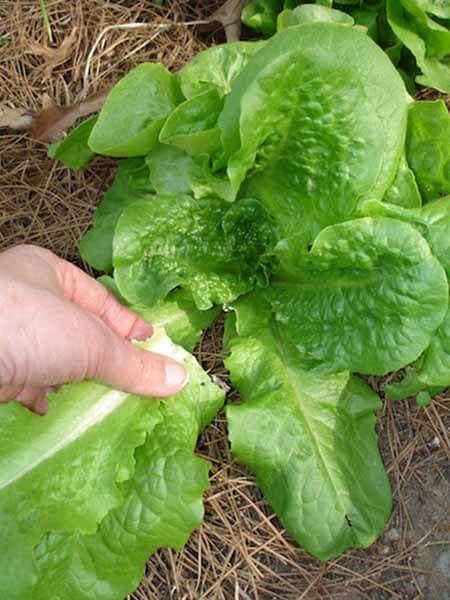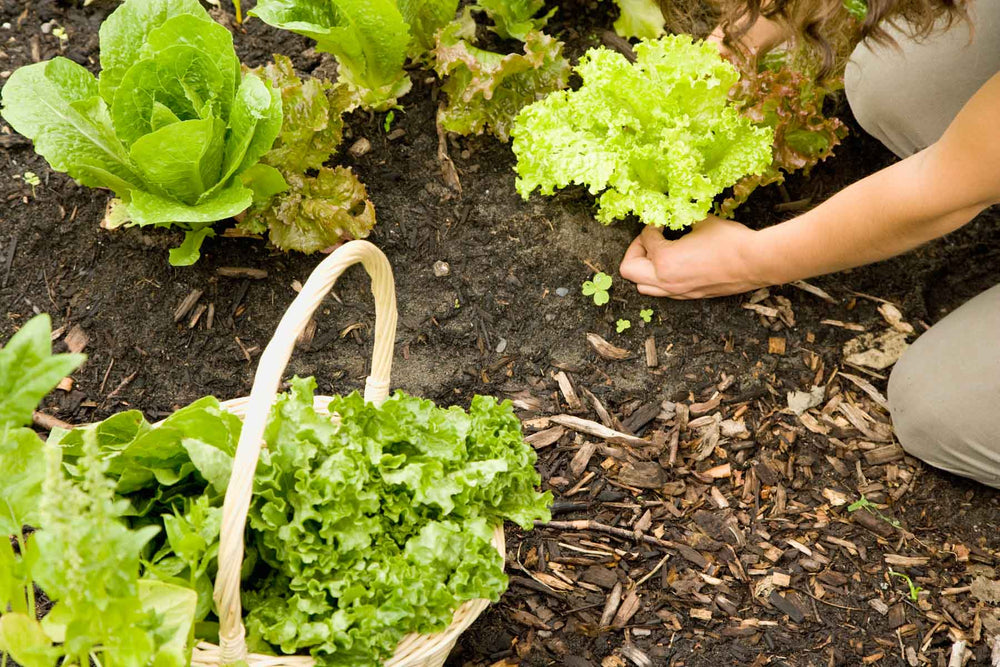If you grow only one vegetable other than tomatoes, it should be lettuce. Growing lettuce is so easy, takes up little space, and you can even grow it among flowers. Lettuce grows for many weeks in the mild weather of spring and fall. Leaf lettuce is easy to tuck in between and under taller vegetables, and is perfect for containers. See our online catalog for more about the different types.
Quick Guide to Growing Lettuce
- Plant lettuce during the mild weather of early spring and fall. This nutritious, leafy green is a great option for in-ground gardening, raised garden beds, and containers.
- Space lettuce plants 6 to 18 inches apart (depending on the variety) in an area that gets an abundance of sun and has fertile, well-drained soil with a pH between 6.0 and 7.0.
- Improve native soil by mixing in several inches of aged compost or other rich organic matter.
- Well-hydrated lettuce will bear tender leaves, so keep moisture levels consistent by watering whenever the top inch of soil becomes dry.
- Prevent weeds and make your watering efforts last longer by applying a thick layer of mulch made from finely ground leaves or bark.
- Promote excellent leaf production by regularly feeding with a water-soluble plant food.
- Harvest leaf lettuce starting with the outermost leaves once they are large enough to eat.
Soil, Planting, and Care
Although lettuce grows fastest in full sun, it is one of the few vegetables that tolerates some shade. In fact, a spring crop often lasts longer if shaded from the afternoon sun as the season warms. You can grow lots of lettuce in a small space, even a container. Mix it with other taller plants, such as tomatoes in the spring, or grow a mix of different varieties for a living salad bowl.
Give lettuce fertile, well-drained, moist soil with plenty of rich organic matter and a pH between 6.0 and 7.0. To check pH, test the soil with a purchased kit, or get a soil test through your regional Cooperative Extension office. Fertilize and lime according to test recommendations.
If you don't do a soil test, then assume that the soil isn't ideal. Add nitrogen-rich amendments such as blood meal, cottonseed meal, or composted manure, or simply mix in Miracle-Gro® Performance Organics® All Purpose In-Ground Soil with the top few inches of your native soil. When growing lettuce in pots, give the roots their ideal growing environment by filling the containers with a premium quality potting mix such as Miracle-Gro® Performance Organics® All Purpose Container Mix. Leaf lettuce needs nitrogen to grow tender, new leaves quickly, so fertilize throughout the growing season with Miracle-Gro® Performance Organics® Edibles Plant Nutrition Granules.
In the spring, begin setting out lettuce plants about a month before the last frost. Lettuce grows best within a temperature range from 45 to about 80 degrees. Hot weather makes it bitter; extreme cold freezes it. When well rooted, some Bibb types such as Buttercrunch will tolerate a surprising amount of frost.
Plant fall lettuce beginning about 4 to 8 weeks before the first frost. If you use a cold frame or row cover, gardeners in many areas of the country can grow lettuce through the winter.
Lettuce spacing is not an exact science, but Bonnie varieties tend to do best with spacing between 6 and 18 inches (depending on type, so check the tag). Generally, you should space plants far enough apart so that they can grow to full size. However, many gardeners plant lettuce much closer together, preferring to harvest leaves continuously before they reach full size. The plants adapt to their spacing.
For the most tender, succulent leaves, water regularly during dry weather. Also, mulch to keep the soil cool and moist, and prevent weeds.
Troubleshooting
The most common lettuce pests are aphids. They love the tender leaves and like to hide on the undersides and down in the crown of the plants.
Harvest and Storage
You can harvest leaf lettuce from the outside of the plant, leaving the central bud to grow more leaves, or you can cut the entire plant at the base. Leaf lettuce is ready to eat at just about any size, and you can pick the baby leaves for tender salads. Romaine lettuce forms its characteristic mid-rib before harvest; at full size it makes an upright leafy clump. Bibb types such as Buttercrunch form a loose head; you can harvest anytime, but for the classic Bibb rosette, wait until the lettuce is nearly full size (6 to 8 inches in diameter) and cut it at the soil line.
The same is true for heading iceberg types; however, in warm climates where head lettuce doesn't make a firm head, you can harvest it like a leaf lettuce, removing leaves as they get large enough to eat.
Lettuce tastes sweetest in cool weather, which is why it is such a great fall crop. As the weather warms, plants will go to seed. By the time they begin to stretch and send out a seed stalk (called bolting), the leaves are bitter. When this starts to happen, harvest all your lettuce immediately and try storing it in the refrigerator, where some of the bitterness may disappear.



FAQs
Is leaf-type lettuce easier to grow than the head-type?
Yes. Leaf lettuce generally matures fast, which makes it ideal for home garden production. Most leaf-type lettuce varieties will mature in seven to eight weeks, but can really be harvested anytime you see leaves big enough to eat. Just take off the outer leaves and let the inner leaves stay to get bigger. Head lettuce varieties take a little longer and are more sensitive to warm weather.
The tips of my lettuce leaves are turning brown, but the base looks healthy. What is the problem?
Browning, or scorching around the margins of leaves is often caused by too little water. During dry weather be sure to water and keep the soil mulched. If the plants are getting enough water, perhaps the roots have been injured from too much fertilizer, nematodes, or too close cultivation. A lack of potassium and calcium can also cause the margins to scorch.
My lettuce plants have grown tall and flowered. What should I do?
It's time to pull your lettuce up. The flowering stalks form at the end of the spring growing season when the days are longer and warmer.
My lettuce tastes bitter. Is it the variety?
No, all lettuce gets bitter during hot weather and when the flower stalks begin to form. You can store the leaves in the refrigerator for a day or two to see if some of the bitterness will disappear. Some gardeners like the slightly bitter taste to add punch to a salad.





 Herbs
Herbs
 Vegetables
Vegetables
 Fruit
Fruit
 Flowers
Flowers
 Succulents
Succulents

